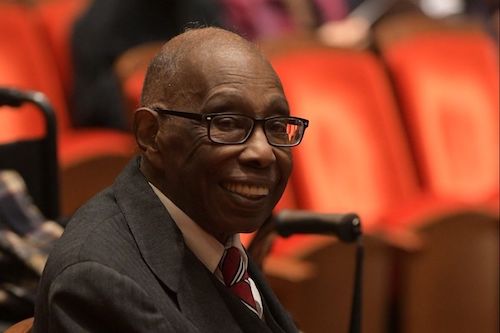by Peter Feher

The singers had the night off, but the full orchestra was onstage May 27, at ease with compositions calculated to unsettle. Music director Franz Welser-Möst led a trio of contemporary symphonic works where challenges abound for performers and listeners alike.
Happily, everyone was on familiar ground for George Walker’s Lilacs (1995), which had its first outing in Cleveland earlier this season. The soloist then — soprano Latonia Moore, who also features on the Orchestra’s forthcoming recording of the piece — had to bow out of Friday’s performance at the last minute. But Nicole Cabell was ready to step in, handling both the beauty of the text and the dissonance of the vocal writing with sensitive, studied understanding.
The four movements of Walker’s song cycle, based on a poem by Walt Whitman, set the audience adrift in recognizable gestures — the twittering of a flute like a bird, the intoning of a French horn along the lines of an elegy. Melodies occasionally take shape, like in a passage that borrows the tune of an African American spiritual, exceptions to the composer’s otherwise atonal language.
For a more complete picture of his legacy, members of the Orchestra put Walker’s most famous work at the center of a concert in Reinberger Chamber Hall that acted as prelude to the weekend’s performances. The slow movement from his String Quartet No. 1, better known as the Lyric for Strings, was the expressive highlight of a program titled “Honoring Black Composers.”
Expertly played, the Lyric had the transporting quality of another favorite adagio for strings, Samuel Barber’s, written just a decade earlier. In fact, the swirl of influences that surrounds composers was a theme across the chamber selections, from the ragtime-inflected final movement of H. Leslie Adams’ Violin Sonata to the soulful fiddling in a section of Dolores White’s Blues Dialogues.
The question of whether to work within a tradition or rebel against it informed the evening’s other symphonic pieces. Back in Mandel Concert Hall, Russian composer Sofia Gubaidulina turned this struggle into the formal conceit for The Light of the End (2003), juxtaposing the different tuning methods possible with the instruments of the orchestra.
The brass section, representing natural tuning (think the series of notes produced without a change in fingering), dug into the ugliness of their parts impressively. But Gubaidulina’s work ends in harmony, with ascending scales on the crotales reminiscent of the final bars of the first movement of Shostakovich’s Fifth Symphony — implying that tradition is not so easy to evade.
Finnish composer Jüri Reinvere presents another conflict, between art and history, in Norilsk, the Daffodils (2012). Here, music serves mostly as underscoring to a poem that imagines a mother singing to her child in a Soviet labor camp. The text is really the achievement, not the score, which suggests that, for an orchestra at least, there are limits to breaking convention.
Published on ClevelandClassical.com June 1, 2022.
Click here for a printable copy of this article

